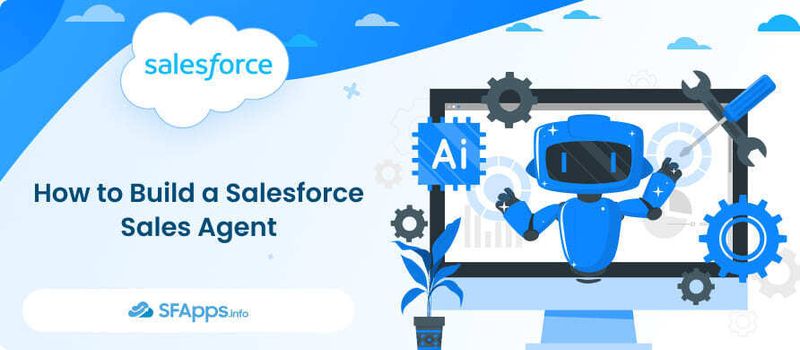When Your Sales Team Can’t Keep Up With Leads
Imagine your Salesforce dashboard showing a hundred new leads from last week’s campaign, but your reps are still catching up on yesterday’s follow-ups. Notes remain unfinished, response times stretch into hours, and potential deals quietly slip away.
According to the Salesforce State of Sales Report, sales reps now spend only 30% percent of their week actually selling, while most of their time goes on tedious and manual tasks.
Image source: Salesforce State of Sales Report
So how can you close more deals without adding more people? At this point, an AI Sales Agent powered by Agentforce steps in to keep the process moving. It automates early-stage sales activities so your team can finally focus on what matters most, selling.
- What Is a Salesforce Sales Agent
- Why Build a Salesforce AI Sales Agent Now?
- Types of Salesforce Sales Agents
- Define the Role of Your Salesforce Sales Agent
- Sales Agent Functions Across the Funnel
- How to Build Your Agentforce Sales Agent Step by Step
- Troubleshooting and Common Pitfalls
- How an AI Sales Agent Helps Daily Sales Work
- FAQs About Salesforce Sales Agents
- Final Takeaway: From Manual to Intelligent Sales
In this article, we explain how to build an AI Sales Agent step by step, from setup in Agentforce Studio to real use cases that improve daily sales work.
What Is a Salesforce Sales Agent
A Salesforce Sales Agent is an AI-powered, autonomous assistant built on Agentforce that augments human sales teams. It supports sales activities such as lead nurturing, data updates, and coaching, working alongside reps rather than replacing them.
Instead of spending hours entering data or qualifying new leads, the agent can manage these steps in real time, right inside your CRM.
Insight:
The McKinsey Global Institute reports that automation and AI could take over nearly one-third of repetitive work hours by 2030, showing how quickly manual sales tasks such as data entry, qualification, and scheduling can be automated inside Salesforce.
AI agent connects directly to Salesforce records, using existing objects such as Leads, Opportunities, and Accounts. The agent can send follow-up messages, book meetings, update deal stages, or flag high-priority opportunities for a rep to review. Each action is guided by company data and sales rules you define in Agentforce Studio.
How Agentforce’s Atlas reasoning engine works
While the agent processes information, scores leads, and schedules next steps, your team can spend time talking to prospects and closing deals. It works quietly in the background, making sure every lead moves through the funnel without delay.
Why Build a Salesforce AI Sales Agent Now?
Sales cycles are getting shorter, but the workload around them keeps growing. Reps must log activities, update pipeline data, and personalize outreach at every step. Without automation, this means hours of admin work for every hour of actual selling.
In response, many companies are turning to AI-powered tools inside Salesforce. The latest releases of Agentforce make it possible to create an assistant that supports the entire sales process: from capturing new leads to sending reminders for follow-ups.
Building a Sales Agent Salesforce environment helps your team keep up with this shift. You gain a system that works continuously, updates records instantly, and provides the context your reps need to act fast. Instead of waiting for data, they can move straight to conversations that close deals.
Insight:
Industry research shows the same trend.
According to the Salesforce State of Sales Report 2024, 81% of sales teams are already investing in AI to boost productivity and personalization.
McKinsey reports that 19% of B2B decision-makers are already implementing gen-AI use cases for buying and selling, and another 23% are in the process of doing so.
Types of Salesforce Sales Agents
Salesforce now provides several specialized agents under the Agentforce for Sales model. These agents work together to handle every part of the sales cycle, from inbound leads to nurturing and coaching.
1. Agentforce Lead Nurturing (formerly Salesforce SDR Agent)
This agent (formerly Sales Development Representative or Salesforce Agentforce SDR) focuses on nurturing leads through personalized outreach and scheduling meetings. It sends automated emails, tracks when prospects book meetings, and supports multi-agent setups for different customer segments.
2. Agentforce Inbound Lead Generation
This new agent template helps teams capture and qualify inbound web leads automatically. It can respond to inquiries, collect prospect data, and schedule meetings without manual input, improving response speed and lead capture efficiency.
3. Agentforce Sales Management
Designed for sales managers and pipeline owners, this agent reviews calls, emails, and notes linked to opportunities and suggests updates to fields such as “Next Step” or “Stage”. Updates appear in Pipeline Inspection, allowing teams to maintain clean, accurate pipeline data.
4. Agentforce Sales Coach
A built-in digital coach that supports sellers with interactive role-playing and real-time feedback. It now supports multiple languages, allowing teams to practice sales conversations globally.
Configurations for Agentforce Lead Nurturing follow the familiar setup pattern of legacy SDR agents Salesforce. The updated Salesforce Agentforce SDR agent name now refers to the same lead-nurturing workflow under the new model.
Want to improve your sales with Agentforce Sales Agent?
Let our experts guide you every step of the way!
Define the Role of Your Salesforce Sales Agent
A successful agent starts with a clear purpose. Before setup, outline what your sales team needs help with and how automation should fit into daily work.
1. Identify Key Responsibilities
List repetitive or time-consuming tasks that your sales reps handle each day, such as:
- Qualifying new leads from campaigns,
- Sending reminders or follow-up messages,
- Updating opportunity stages or account notes,
- Preparing daily activity summaries.
These activities are strong candidates for automation inside Salesforce.
2. Decide What the Agent Should Handle
Some tasks are perfect for automation, while others still need a human touch. For example:
- Your Salesforce Agentforce Sales Agent could qualify new leads, assign them to reps, and send follow-up emails automatically.
- Human reps can handle negotiation, relationship building, and deal closing.
3. Define Clear Rules
Write down what the agent can and cannot do. A simple list of “agent-owned” versus “rep-owned” tasks keeps responsibilities clear and improves adoption across the team.
Thanks to early role definition, agent onboarding becomes smoother, testing goes faster, and your sales team immediately understands how to collaborate with their new digital colleague.
Sales Agent Functions Across the Funnel
A Salesforce agent works best when its actions align with each stage of the sales funnel. From first contact to renewal, each activity can be automated or supported by your agent to keep deals moving forward.
A Sales Agent can manage each of these actions automatically, ensuring leads are never left unattended.
By connecting data from Marketing Cloud, Sales Cloud, and CRM Analytics, an Agentforce Sales Agent helps sales teams maintain visibility, shorten follow-up times, and keep every opportunity on track for closure.
How to Build Your Agentforce Sales Agent Step by Step
You can build your own agent Salesforce directly inside Agentforce Studio using Salesforce’s standard setup tools, no complex coding required. Follow these steps to create a working agent that supports your sales team.
For testing, you can use a Developer Edition org, which includes Agentforce by default. Also, make sure Einstein Generative AI is enabled to support natural-language actions.
1. Enable Agentforce
In Setup, open the Agentforce section and enable it for your org. Make sure Sales Cloud and Data 360 (formerly – Data Cloud) are active, since Agentforce uses these to pull context and customer data. Assign permissions to admins and test users who will configure and monitor the agent.
Agentforce Agents in Salesforce Org Setup
2. Create a New Sales Agent
Go to Agentforce Studio and click “New Agent”. You can either start from scratch or choose a predefined template.
Template selection menu for creating an AI agent
For a sales use case, simply create a custom agent and name it clearly, for example, “Agentforce Lead Nurturing” (previously known as SDR Agent Salesforce) or “Agentforce Sales Coach”.
3. Add Topics
Topics define what your agent knows and can handle. Add pre-made Topics, or create your own. Each topic represents a specific workflow or customer interaction.
Choosing Topics for an AI Agent
4. Define Actions
Every topic needs at least one action, connected through Flow, Apex, or Prompt Templates. For example, an Agentforce Lead Nurturing agent might automatically score leads or create follow-up tasks. These actions link your agent’s logic to Salesforce data and ensure that routine work happens automatically.
Creating a New Action for a Topic
5. Test in Agentforce Testing Center
Before going live, simulate conversations in the Testing Center. Check how the agent retrieves data, responds to users, and escalates complex requests. Fix permission issues or dialogue gaps to guarantee a smooth launch.
Agentforce Testing Center in Salesforce Org Setup
6. Deploy and Connect
Once testing is complete, activate your agent and link it to channels such as Sales Cloud, Slack, or digital engagement tools. Powered by the Salesforce Einstein Sales Agent model, your agent can interpret context, draft messages, and provide recommendations that sound natural to your users.
7. Monitor and Improve
After deployment, track its performance through Agentforce Analytics. Review completion rates, missed interactions, and feedback trends to refine flows or add new capabilities.
If your team already uses automated service workflows, a setup similar to the Salesforce Agentforce Service Agent can extend the same automation principles to support functions.
Need assistance with Agentforce Sales Agent setup?
Our specialists can help you set it up quickly and easily!
Troubleshooting and Common Pitfalls
Even a well-built agent can encounter issues after deployment. Most problems with a Salesforce AI Sales Agent come from setup or permission errors, not from the AI model itself. Here are the most common challenges and how to fix them.
Pitfall #1. The Agent Doesn’t Respond to Users
Check its data permissions. If the agent can’t access Lead, Contact, or Opportunity objects, it won’t be able to act. Update permission sets and test again.
Pitfall #2. Actions Fail to Run
Verify that related Flows or Apex actions are active. Inactive automation often blocks execution. Re-activate and retest the topic.
Pitfall #3. Incorrect or Incomplete Answers
Add more context to prompts or expand the topics list. An agent with too few topics struggles to interpret requests correctly.
Pitfall #4. Duplicate or Conflicting Tasks
Ensure only one flow or action is assigned to each condition. Duplicated logic causes multiple task triggers for a single event.
Pitfall #5. Slow Response Time
Review connected systems. Large data calls or integrations can slow the agent. Caching or narrowing query scopes improves speed.
Regular checks through the Agentforce Observability help prevent these issues. Review logs weekly to confirm that your agent stays reliable and up to date with workflow changes.
How an AI Sales Agent Helps Daily Sales Work
A Salesforce agent improves daily performance across the sales team by managing repetitive tasks, organizing data, and ensuring that every lead moves through the funnel without delay.
1. Handling Everyday Sales Tasks
An Agentforce Sales Agent can take over routine work that consumes most of a rep’s day. Typical activities include:
- Qualifying new leads from forms or campaigns,
- Assigning leads to the correct rep,
- Sending short follow-up messages,
- Logging notes and updates automatically.
By handling these actions in real time, the agent keeps leads active and prevents missed follow-ups.
2. Supporting Reps and Managers
The agent assists both frontline sellers and their managers, for example, it can:
- Summarizes meeting outcomes and adds them to Opportunities
- Updates stages and close dates
- Flags deals that need attention or next steps
This ensures the pipeline is always up to date and ready for forecasting.
3. Saving Time Across the Team
An Agentforce Sales Agent can save hours each week by automating routine updates, reminders, and status reports. Sales reps gain more time for customer conversations, while managers can focus on coaching and planning instead of manual data cleanup.
Together, these improvements create a more organized, faster, and predictable sales process that keeps every opportunity moving toward closure.
Looking to build your own Agentforce Sales Agent?
FAQs About Salesforce Sales Agents
1. Can I build Salesforce Sales Agent without coding?
Yes. Agents are configured in Agentforce Studio, where you can define topics, actions, and prompts through a simple interface. No Apex or custom code is required for basic setup.
2. How is it different from Service or Support Agents?
While Service and Support Agents focus on customer requests, Sales Agents handle lead qualification, opportunity updates, and daily sales activities directly in Sales Cloud.
3. Does it connect to CRM data automatically?
Yes. The agent works with Salesforce objects such as Leads, Contacts, and Opportunities, using existing permissions and sharing settings.
4. Can it send emails or create tasks automatically?
It can. Once topics and actions are linked to Flows or templates, the agent can send personalized messages, create reminders, or assign tasks instantly.
5. How can I measure its performance?
You can track response time, task completion rates, and lead conversion metrics through Agentforce Analytics or custom dashboards inside Salesforce.
Final Takeaway: From Manual to Intelligent Sales
A well-planned AI Sales Agent turns daily sales operations into a continuous, automated process. Once configured, it captures leads, updates records, and delivers insights faster than any manual workflow.
For growing teams, this shift means more accurate data, quicker decisions, and fewer missed opportunities. AI automation inside Agentforce is no longer limited to large enterprises, any company using Sales Cloud can build an agent that works alongside its team.
Sales managers gain a real-time view of the pipeline, while reps focus on customers instead of admin work. With regular updates and performance checks, your agent keeps improving and adapting to business changes.
The post How to Build a Salesforce Sales Agent first appeared on Salesforce Apps.


















Top comments (0)